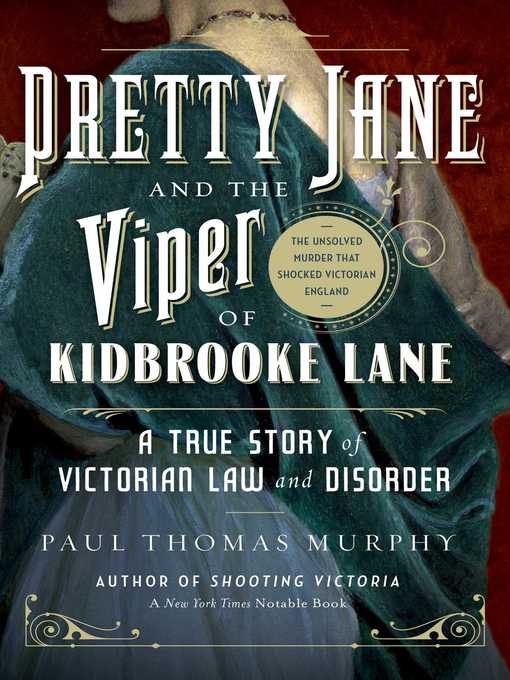
Pretty Jane and the Viper of Kidbrooke Lane
- اطلاعات
- نقد و بررسی
- دیدگاه کاربران
نقد و بررسی

January 25, 2016
Murphy (Shooting Victoria) displays a novelist’s gifts in this fascinating true crime account of an obscure 1871 London murder. Early one April morning (“just as definition and color began to bleed into the amorphous black and gray”), a constable patrolling a deserted footpath came upon a hideously wounded woman, who cried “ ‘let me die,’ ” before falling unconscious. It took several days for the unidentified woman to succumb to her injuries, and it was several days after that when William Trott recognized the body as his niece, Jane Maria Clouson, who was working as a maid at the time of her death. When the autopsy revealed that Jane was pregnant, Jane’s relatives disclosed that she had spoken of a relationship with Edmund Pook, the son of her employer. After prematurely arresting Pook, the police scrambled to keep the case against him alive, despite its basis in hearsay evidence. Murphy captures the drama of the flawed investigation, and the legal proceedings that followed. His solution to the crime—based on current forensic science—is likely to be the last word on the case. Agent: Charlie Olsen, Inkwell Management.

February 1, 2016
Murphy (Interdisciplinary Writing/Univ. of Colorado; Shooting Victoria: Madness, Mayhem, and the Rebirth of the British Monarchy, 2013) exposes the inequities of British justice in the 1871 case of Jane Clouson, who was "found attacked and horribly disfigured on a quiet country lane outside of Greenwich." Using a hammer, the culprit struck the teenage victim up to 15 times, crushing her skull and brutalizing her face. The author outlines an intriguing story of police who were overly sure of the man they arrested for the murder. After the girl, two months' pregnant, was identified by her family, the investigation led to the home of Ebenezer Pook, where she had been employed as a maid. Satisfied that Pook's son, Edmund, was the guilty party, despite his uncanny calmness and denial, the police arrested him. However, they made a number of mistakes, jumping the gun and neglecting to give the customary caution against self-incrimination. Edmund consistently denied anything to do with that "dirty girl," and his imperturbability continued through hearings in front of the magistrate at Greenwich, the inquest, and his trial. At the trial, Judge William Bovill, who seemed to be clearly in favor of the defendant, refused the admission of what was termed "hearsay." That evidence--plus Jane's statements to two people naming the baby's father and claiming she was planning to go away with him on the day of the murder--could have completed the case. The defendant's clothing was spotted with blood, though it could only be identified as mammalian. The author's strong knowledge of Victorian culture helps him clearly describe the class conflict this case aroused. The trial and its aftermath demonstrate how class differences doomed those at the lower end. Victorian murder mysteries are usually entertaining. Even without a Sherlock, this highly readable story still shows the cleverness of the police and the frustrations of prosecutors.
COPYRIGHT(2016) Kirkus Reviews, ALL RIGHTS RESERVED.

March 1, 2016
Victorian scholar Murphy (Shooting Victoria) tells the story of Jane Maria Clouson, a working-class servant girl, who was discovered barely alive by a constable on patrol in a remote part of London in April 1871. She was rushed to the hospital and a two-pronged investigation was launched: Who was she and who had tried to kill her? The police quickly turned their suspicions to the son of her former master Edmund Pook. In fact, investigators were so certain of Pook's guilt that they arrested him before having thoroughly dissected the homicide. Pook was eventually acquitted with the help of his attorney Henry Pook (no relation). The public rebelled and broke out with rough music protests. The court cases continued with Henry Pook filing charges against the police for misconduct and libel suits against the writer and publisher (and seller) of a pamphlet describing Edmund Pook as the killer. With the hindsight of history, Murphy lays out a compelling theory as to why he thinks Pook did indeed murder Clouson. Murphy also details two other trials taking place at the same time--hopefully these will inspire his next book. VERDICT This fascinating account of a Victorian murder, complemented by the added strength of a rich description of the period's society and judicial system, should be a solid addition to academic and true crime collections.--Karen Sandlin Silverman, Scarborough H.S. Lib., ME
Copyright 2016 Library Journal, LLC Used with permission.




دیدگاه کاربران